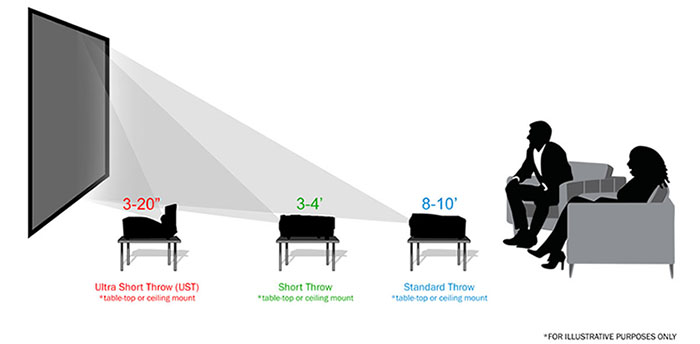
Source: Elite Screens Inc.
This article addresses the main characteristics of Standard, Short Throw, and UST projectors as well as the materials that are most compatible with them. Before we start, let’s discuss throw distance since it is what sets these 3-projectors apart.
Throw distance is the measured expanse that the light must travel from the projector’s lens to the projection screen’s surface. Standard throw projectors typically create a 100” (16:9) image footprint from about 10 feet of throw distance. Short throw projectors can create the same sized image from less than half that distance (about 4 feet), and UST projectors will put up the same sized image in a matter of inches.
The three basic types of projectors are Standard Throw, Short Throw (ST), or Ultra Short Throw (UST).
Standard or "Long Throw" Projector
In order to create a 100” / 254cm (16:9) image, will typically require about 8-10 feet (244-305cm) of throw distance.
• Strengths are versatility and cost.
• Weakness is the amount of space they can take up in any application. Another side effect of “long throw” is that when people, animals, or any other objects come between the projector and screen, it will create a shadow over the projected image.
Short-Throw Projector
In order to create a 100” / 254cm (16:9) image, will typically require about 3-4 feet (90-120cm) of throw distance.
• Strength is its ability to work well at giving a big picture in close confines.
• Weaknesses are its inability to work with anything but a perfectly flat projection surface and that it is not at all compatible with any type of ALR (Ambient Light Reflecting) materials.
Ultra Short Throw Projectors
In order to create a 100” / 254cm (16:9) image, will typically require about 3-20 inches (8-50cm) of throw distance.
• Strength is its ability to work well at giving a big picture in close confines. Flush design eliminates the shadow problem making it ideal for training or home theater applications. CLR projection materials are available for them.
• Weaknesses are its inability to work with anything but a perfectly flat projection surface. Limited availability of larger CLR material sizes (for now).
In summary, a standard projector goes with just about everything, whereas short throw projectors require a tensioned-flat surface but make installation a lot more convenient. For wide open spaces, the traditional design is best. A short throw is better for training environments; while a UST projector is the best bet for a tight spot.